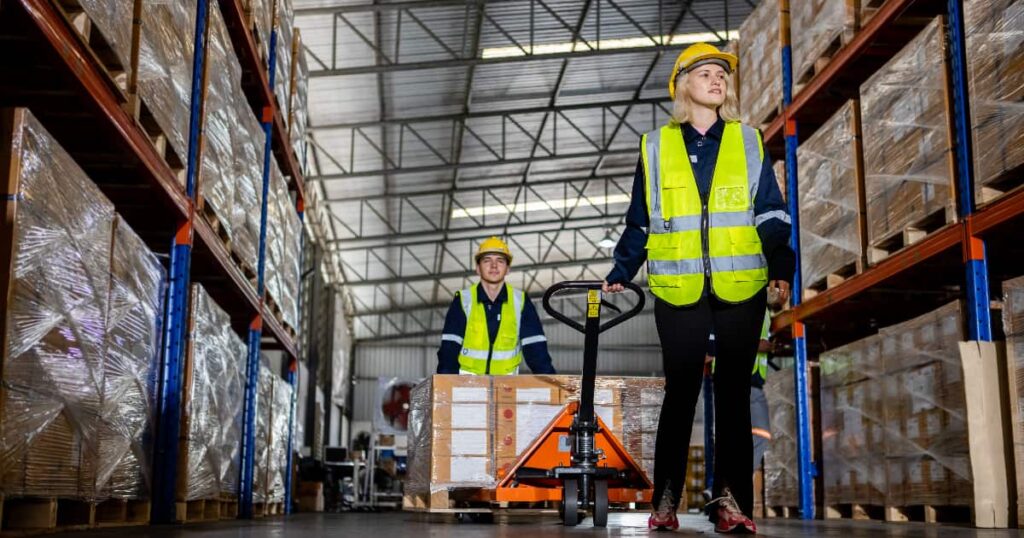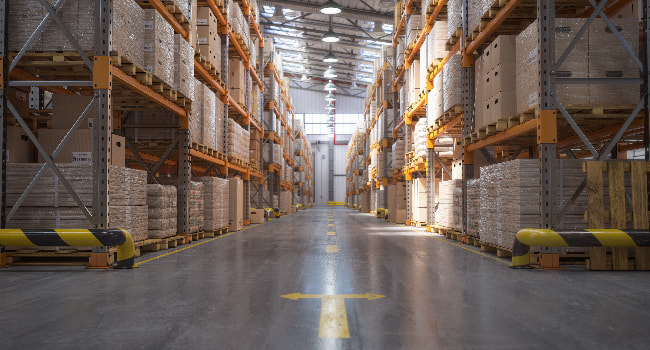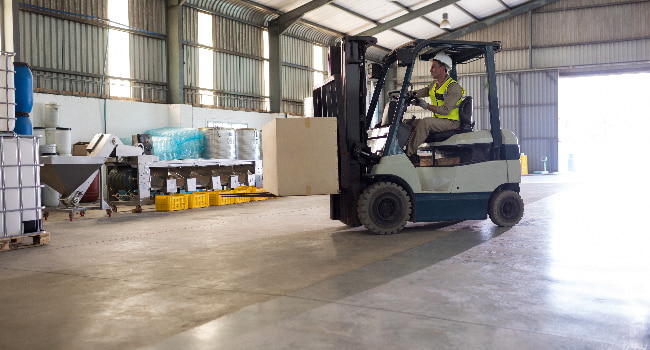A1 Quality Logistical Solutions

- By Haley
- August 14, 2025
Table of Contents
Key Highlights
- Gain a clearer perspective on how lean warehousing transforms traditional inventory management and logistics operations for enhanced cost savings.
- Understand the seven types of waste affecting warehouse operations, from overstocking to inefficient processes.
- Discover effective techniques like slotting optimization and value stream mapping for improved workflow and space utilisation.
- Learn how advanced technologies, such as warehouse management systems and automation, refine supply chain operations.
- Get expert guidance on empowering warehouse staff to foster a culture of continuous improvement and teamwork.
- Access solutions for tackling space constraints and balancing lean principles with evolving customer expectations.
Introduction
When a warehouse runs on lean ideas, it helps cut down waste, makes sure things move well, and uses resources in the best way. As customers want more, the pressure to make every part of logistics work better and fix weak spots also goes up. Lean warehousing is a way for businesses to change, improve, and stay strong in the market. In this blog, I will take you through what lean warehousing is, its benefits, and how you can use its methods to make your supply chain work better.
Understanding Lean Warehousing
Lean warehousing is all about taking out wasteful steps in warehouse operations. The goal is to make every process work better and faster. This way of working comes from lean manufacturing ideas. By using these methods, businesses can make customers happier, lower costs, and get better results in the supply chain. Lean warehousing depends on clear logistics and better workflows for its success.
When you integrate lean methods into warehouse operations, things start to work smoother. The team works to always get better, change with needs, and use resources wisely. This helps make order fulfillment easier and improves inventory management. It also lets companies set and reach better performance goals. All these steps help different industries in the supply chain and make customer satisfaction stronger.

What Is Lean Warehousing?
Lean warehousing is all about cutting out waste and making things run smooth in warehouse management. It takes ideas from lean manufacturing to help give value to customers. The goal is to keep quality high, make work flow faster, and boost how much gets done.
In supply chain management, lean warehousing brings together things like better inventory handling, easier fulfillment operations, and smarter use of space. When you have clear talk between teams, fewer mistakes, and better logistics services, the business can meet and often go past what customers expect.
Warehouse management under lean warehousing uses ways to get better all the time and involves everyone working there. This kind of setup helps bring real cost savings, quicker order processing, and lower shipping costs. It also helps build a supply chain that bounces back fast and can change with what customers want.
Key Principles of Lean in Warehousing
Lean practices focus on a few key ideas that shape how a warehouse works:
- Value-Added Activities: Put your energy into tasks that customers care about. This includes things like making sure each order is filled right and sent on time.
- Continuous Improvement: Look at the way you work all the time. Improve the steps one by one to get rid of waste and help warehouse operations become smoother.
- Workplace Organization: Use systems like 5S—Sort, Set in Order, Shine, Standardize, Sustain. These steps help you keep inventory management in order and also help with your daily logistics services.
When you focus on how inventory moves, control extra stock, and keep work simple, your warehouse gets better at what it does. These ideas lift up the whole supply chain. The way you manage order fulfillment, organize things, and fix problems will change for the better. You also let your team find new ways to work that help everyone do their best.
Differences Between Traditional and Lean Warehousing
Traditional warehousing is known for using bulk storage and old-style ways of working. This often brings many problems and makes things slow. Lean warehousing is different. It helps cut waste, work better, and puts a strong focus on both cost savings and customer satisfaction.
Lean warehousing helps boost inventory turnover and makes supply chain operations easier. It does this by using new tools like warehouse management systems. The main point is to match exactly what the customer wants, always deliver on time, and make good use of the warehouse space you have.
Aspect | Traditional Warehousing | Lean Warehousing |
Inventory Management | Overstocking and bulky storage | Optimized inventory levels |
Workflow Flexibility | Manual processes and rigid systems | Flexible, automated workflows |
Focus Area | Holding stock | Continuous improvement & customer focus |
This change lets the business move toward higher levels of efficiency. It also helps them stay ready and adapt in a fast-changing world of logistics and supply chain operations.
Identifying Waste in Warehouse Operations
Waste in warehouse operations can slow down work and delay order fulfillment. Problems like too much inventory, slow workflows, and not enough use of warehouse space bring down how well things run and push up costs. It is important to know where the waste is so that you can use lean warehousing the right way.
By using tools like performance numbers and feedback from employees, you can find out where things are going wrong in different supply chain functions. Knowing the types of waste helps you use lean practices, which leads to better warehouse operations and makes customer satisfaction higher.

The Seven Wastes in Warehousing
There are seven main types of waste in a warehouse.
- Overproduction: This means you have more stock than needed in the warehouse.
- Excess Inventory: When inventory management does not go well, and there is more stock than what people need now or soon.
- Unnecessary Transportation: Products move around in the warehouse more than they should, which puts extra load on transportation services.
- Idle Waiting Time: Workers have to wait because of problems in the schedule, so their time is not used well.
- Defects: There are issues like products being damaged, having errors, or wrong items getting shipped out.
- Inefficient Motion: When workers do tasks that do not help get the orders ready faster or do not add any real value to order fulfillment.
- Underutilisation of Space: Warehouse space that is not managed well leads to the place becoming too full or some places not being used at all.
If you take care of these types of waste, your supply chain can get a lot better. Lean warehousing helps your business use its warehouse space, inventory management, order fulfillment, and transportation services in a way that works well for all parts of the supply chain operations.
Common Signs of Inefficiency
Without using lean strategies, the supply chain can have major concerns. You might see things like:
- Stores often running out of stock because the inventory guesswork is wrong.
- People getting their customer orders late because the order processing takes too long.
- Storage space getting messy. This can make the warehouse operations confused.
- Shipping costs going up if transportation routes or order volumes are not managed well.
When there are more of these problems, customer satisfaction drops and the work costs more, too. If you spot these things early, you can move to lean warehouse operations more smoothly.
How to Measure Waste in Your Warehouse
Understanding waste in warehouse operations means you need clear numbers and a careful look at how things work. A warehouse management system (WMS) helps with this. It shows real-time data on inventory levels, employee work, and order steps.
Some of the key things to watch are shipping costs that depend on travel time and number of times you move your stock. Tools like predictive analysis help you spot where work gets stuck or problems keep coming up in fulfillment operations.
Measuring waste is not only about saving resources. It also helps you give better logistics services to customers, which leads to more customer satisfaction.
Core Strategies for Lean Warehousing
Focusing on being efficient and cutting down waste is important in lean warehousing. Using the 5S method helps keep things neat and organized. This also makes inventory management easier. When you set up standard ways to do tasks, operations stay the same every day. This helps with order fulfillment and makes supply chain management better.
Also, value stream mapping is useful to spot places in warehouse operations that need work. This way, businesses can get rid of activities that do not add value. It makes logistics operations better and helps save money. In the end, this brings higher customer satisfaction and cost savings for businesses. These key things give a good start for a strong lean warehousing system.

Implementing 5S Methodology
The 5S method is very important when you want to get the most out of your warehouse operations. It stands for Sort, Set in Order, Shine, Standardize, and Sustain. By following these steps, you can improve inventory management and help everything flow better in your workplace. The 5S method helps you have a clean and neat warehouse. This makes it easier for warehouse workers to manage orders and watch inventory levels. When you set things up this way, you save money on costs, improve service, and make the customer experience better. This way, you build a strong base for your fulfillment and make your logistics operations run smoother.
Standardizing Workflows and Procedures
Having fixed workflows and set ways to do things is key to making warehouse operations work better. When you use the same steps every time, it helps cut out confusion. This is good for both inventory management and order fulfillment. Doing things the same way helps with logistics operations, and it also makes it easy for warehouse workers to talk to each other. Everyone knows their job, and they all work toward the same goals.
Making training plans that match these set ways helps build accountability. It gives supply chain visibility, so it’s easier to watch what’s going on. This helps people make better decisions. In the end, it can make service in the distribution center run smoother. The result is better customer satisfaction and a stronger fulfillment process.
Value Stream Mapping for Warehousing
Value stream mapping is important for making warehouse operations better. It shows every step in inventory management and order fulfillment. This way, people can see how work moves through the warehouse. It also shines a light on where time and resources are wasted. By doing this, warehouse managers get the chance to look deep into supply chain functions and make better choices. They can find out how to make logistics operations run smoother and help customers have a good experience.
When the value stream map gets updated often, warehouses can adjust as inventory levels and customer orders change. Having up-to-date details helps keep service strong and saves costs at the same time. It lets companies improve their supply chain and manage warehouse operations in a way that works well. When these steps get done right, they lead to better order fulfillment and happier customers. Over time, these efforts also give good cost savings for the business.
Improving Warehouse Layout and Flow
The way you set up the warehouse makes a big difference for how well your logistics operations work. If you design the space to let products move easily, workers can get orders out faster. You will see less wasted time, and things do not have to go so far in the building. Using slotting optimization also helps a lot. If you put the most picked items close by, workers can find what they need fast, so orders are filled on time.
This smart setup helps improve inventory management for your business and makes customers happy. The fulfillment process becomes smooth and easy. When you use your storage space in the right way, you save money and keep service good for everyone in your customer base. In the end, businesses that work on their warehouse layout see better cost savings and can serve new and old customers well.

Designing for Optimal Product Movement
Moving products fast in a warehouse is key to speeding up work and making order fulfillment better. If you set up a good layout, you make sure people can get to popular items quickly. This cuts down on travel time and helps with all your logistics operations. Putting products where they are easy to pick, based on order volumes, lets things move smoothly and helps avoid slow-downs. When you use data from warehouse management systems, you can see if products are in the right spot, so you can make better decisions about how to use your storage space. In the end, this smart way of planning gives people what they order on time and helps service providers work better, which leads to higher customer satisfaction.
Reducing Travel Time and Distances
Making warehousing more efficient starts with cutting down on travel time and distance. When you look at the layout of storage spots, you can make sure that workers get quick access to items people ask for a lot. This leads to faster order fulfillment and helps the supply chain move smoother. When you use data from warehouse management systems, it shows you how people move around. This info lets you move goods to better spots and means there will be fewer wasted trips. Using ideas from supply chain management like cross-docking and batch picking will also help goods move quicker. By putting goods close to where they are needed, warehouses can make logistics operations better and improve how everything works.
Slotting Optimization Techniques
Effective slotting optimization can help make warehouse operations run better. When you organize inventory in a smart way, based on order fulfillment patterns, you help warehouse workers move less. This means they take fewer steps and save time. Take a close look at how fast products sell and what people often want. This helps you put items in the right spots, and that matches up with your other logistics operations.
When you use a warehouse management system, you can keep checking and changing your slotting plans. This helps you keep the best inventory levels. When you use these methods, you make the most out of your warehouse space. This also helps service providers work better. In the end, it leads to faster and more correct order processing. This means your customer satisfaction will go up.
Lean Tools and Technologies
Using new tools and technology is key for better lean warehouse operations. A smart warehouse management system (WMS) lets you keep track of inventory in real time. This helps make supply chain visibility better and keeps order fulfillment running smoothly. When you use things like barcoding, it makes logistics work faster, stops people from making errors, and helps boost productivity. On top of that, when you look at real-time data, it helps show how your team is doing. This lets you make better choices about your inventory levels or order processing. All these new ways of working help companies save money and make warehouse operations better for everyone. When this happens, customer satisfaction also goes up, which is good for anyone in the logistics industry.

Warehouse Management Systems (WMS) for Lean
Warehouse Management Systems (WMS) help make warehouse operations better and more simple. These systems give real-time information to you about inventory levels. This helps keep stock levels right in all the warehouse locations. Good order fulfillment is possible because people can see exactly what is in the warehouse. When WMS connect with supply chain functions, there is better coordination with logistics providers and transportation services. This leads to cost savings and better customer service for everyone. Using a WMS makes warehouse management faster and more flexible. So, companies can handle new order processing and changes from their customers in a quicker way. This helps people keep up with what customers want and how things move through the warehouse.
Barcoding and Automation
Big steps in barcoding and automation are changing how warehouse operations work. When you use barcode technology, inventory management gets much easier. Stock levels can be tracked better, and order fulfillment becomes quicker. Automation adds even more value by cutting back on manual jobs. This reduces mistakes done by people and speeds up the whole fulfillment process.
Logistics companies that use these tools see cost savings and better results as a service provider. Bringing barcoding and automation together helps shine a light on the supply chain and makes logistics operations run smoother. In the end, customer satisfaction grows and the business model gets stronger.
Real-Time Data and Performance Metrics
Using real-time data and keeping track of performance makes warehouse operations better. This helps people make good choices in every part of the supply chain. When you use warehouse management systems (WMS), you can see inventory levels and customer orders right away. This means order fulfillment is smooth, and you spend less on shipping costs.
Looking at how long it takes to process orders and at inventory turnover rates shows how work is being done. It helps companies keep getting better. By focusing on data analysis, logistics companies can adjust fast when order volumes go up or down. This also helps in raising customer satisfaction and making fulfillment faster in various industries.
Engaging and Empowering Warehouse Staff
When you create a place where warehouse workers feel involved, you help lean warehousing work better. By offering lean training and teaching programs, staff can learn key skills needed for inventory management and order fulfillment. Working to build a group that always wants to get better lifts morale and helps everything run well. Getting staff to join in on fixing problems gives them the power to turn tough spots into new chances. This way, the whole fulfillment process runs in a smoother way. All this leads to higher customer satisfaction and better logistics operations.

Lean Training and Education Programs
Helping warehouse staff learn more with focused training and regular education is key to lean warehousing. Lean programs teach warehouse workers about waste reduction and value stream analysis. This helps employees better understand inventory management and logistics operations. When people in the warehouse learn more about process efficiency and solving tough problems, the company can boost order fulfillment and customer satisfaction. Putting time and money into staff learning builds up core competencies and creates a strong culture of always getting better. This has a good effect on supply chain functions and how well logistics service delivery works.
Encouraging a Culture of Continuous Improvement
Creating a culture of always getting better in the warehouse helps staff take part in making things run smoother. This leads to better inventory management and faster order fulfillment. When you build a place where feedback is wanted, people in the team get more involved. They help spot things that are not working and give ideas to fix them. This makes warehouse operations better.
Working together in this way helps people feel good about their work. It also matches well with the company’s logistics operations. This teamwork helps everyone make better choices day to day. Giving the team regular training helps them really get what lean means. Over time, they start working for better ways to do things, making not just fulfillment but also customer service work even better.
Employee Involvement in Problem-Solving
Getting warehouse workers involved in solving problems can make warehouse operations work better. These people deal with daily tasks and issues, so they know a lot about what really happens. When you let team members share their ideas and make changes, you use their knowledge and help the business grow. This way, everyone works together and keeps getting better. Working as a team does not just make people feel good at work. It also helps everyone move in the same direction and focus on the right things. This teamwork can improve inventory management, speed up order fulfillment, and increase customer satisfaction in the long run.
Overcoming Challenges in Lean Warehousing
Successfully using lean warehousing principles can be tough and needs smart planning. Change management is key to handle staff pushback, so everyone is working with the new ways. Sometimes, there is not much space in the warehouse. This can make it hard to use good layouts and inventory management methods, so you need to find new ideas to make warehouse operations better.
It is also important to balance lean work with what customers want. To satisfy order fulfillment needs and still save money, your logistics operations and supply chain functions have to be flexible. Doing all this right helps you improve customer satisfaction.

Managing Change and Resistance
Handling change in warehousing can be tough. Many staff are used to the way things are done, so they may not want things to change. Good communication is important. This helps everyone see how lean methods, like better inventory management and simpler workflows, can help them work better. Letting the staff take part in changes helps to lower fear, build trust, and makes people work together. If managers listen to what the staff says and share information openly, everyone can feel better about new ways of working. This makes it easier to try new things, which also helps customer satisfaction and can improve the fulfillment process.
Addressing Space Constraints
Good management of space is very important in getting the best out of warehouse operations. You can use vertical storage solutions to increase the storage space you have. This also helps open up valuable space on the floor. When you use inventory management methods like just-in-time (JIT) replenishment, you keep extra stock low and make better use of your current warehouse locations. Using flexible warehouse layouts can help you adjust the setup fast. This is useful if order volumes and product types often change. Putting money into warehouse management systems gives you better supply chain visibility. It also helps you make sure every bit of space gets used well for order fulfillment and helps improve customer satisfaction. Good supply chain control can lead to better order results and good use of space in all parts of the warehouse.
Balancing Lean Initiatives with Customer Expectations
It is important to see how lean changes and what customers want work together. Using plans that make things run smoother—like cutting down order fulfillment times—can boost customer satisfaction. At the same time, this can help lower costs. But, keeping good service should always come first. If you choose to be cheap instead of efficient, customer experiences might not be good. It helps to always ask for feedback from people so that businesses can change how they work. This way, lean steps and what people want can match. Getting this right helps supply chain and logistics operations get better. It lets a business meet different needs and do well over time.
Conclusion
In the end, using lean warehousing in logistics operations helps cut down on waste and makes things more efficient. This is important for keeping everything on track. When the processes are simple and well-planned, it helps with better inventory management and supports ongoing changes for the better. These steps help the supply chain react quickly and keep customer satisfaction up. Putting main strategies like the 5S method and value stream mapping in place makes the distribution center work better.
Getting the workers involved and using today’s warehouse technology lets companies handle the tough parts of modern logistics with more ease. This way, they can spend less on running things and give better service to their customer base.
Frequently Asked Questions
What are the main benefits of lean warehousing?
Lean warehousing helps make work better in warehouses. It does this by cutting down on waste and making inventory management easier. When you set up a better workflow, you can get more done with less. There is also better use of space, which leads to cost savings. All of this helps make customers more happy with what they get. When companies use simple ways to do tasks and get their workers involved, they can keep making their work better over time. This is good for everyone in the long run.
How long does it take to implement lean strategies in a warehouse?
Putting lean strategies in place in a warehouse usually takes about three to six months. How long it takes can depend on the size of the warehouse and how complex the work is. Success comes from good training, getting everyone involved, and checking on things often. These steps help you make changes without causing big problems for the way work gets done.
Can small warehouses benefit from lean principles?
Yes, small warehouses can really get a lot out of using lean principles. These methods help to use space better, cut down on waste, and make the work easier. When a place uses things like the 5S method and set ways to do tasks, it can get more done each day. This helps workers respond faster, keeps things running smoothly, and makes sure customer satisfaction stays high.

Haley serves as the Marketing Manager for A1 Quality Logistical Solutions. She joined A1QLS in 2023 with her prior experience gained with GXO and XPO Logistics.
